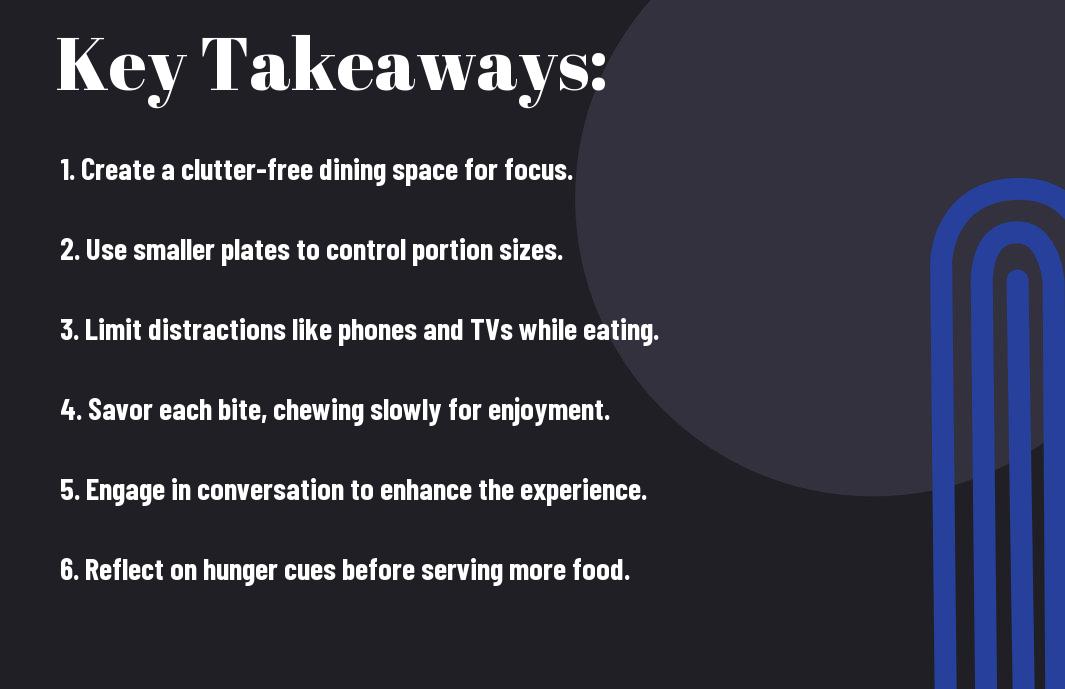With the right strategies, you can transform your dining room into a sanctuary for mindful eating. This practice not only enhances your relationship with food but also promotes a deeper awareness of your eating habits. By making small adjustments to your dining environment and approach, you can cultivate a more intentional and satisfying eating experience. In this post, you will discover practical tips to help you savor each meal and foster a greater connection with the nourishment you provide your body.
Key Takeaways:
- Set the Atmosphere: Create a calm and inviting dining space to enhance the experience of eating.
- Slow Down: Take your time with each bite to savor flavors and improve digestion.
- Limit Distractions: Turn off screens and focus on your meal to foster a deeper connection with the food.
- Engage Senses: Pay attention to the colors, smells, and textures of your food for a more fulfilling experience.
- Practice Portion Control: Serve smaller portions to reduce overeating and encourage mindful reflection on hunger cues.
- Express Gratitude: Acknowledge the food and effort that went into it to cultivate appreciation for your meal.
- Chew Thoroughly: Chewing food well aids digestion and allows you to enjoy each bite more fully.

The Importance of Mindful Eating
While you navigate the hustle and bustle of daily life, it’s easy to overlook the significance of mindful eating. This practice involves being fully present during your meals, allowing you to appreciate the flavors, textures, and aromas of your food. By engaging your senses, you can cultivate a deeper connection to your meals, which can enhance your overall dining experience and contribute to healthier eating habits.
Understanding Mindfulness
At its core, mindfulness is the art of being aware of your thoughts, feelings, and surroundings in the present moment. In the context of eating, it encourages you to slow down and savor each bite, creating an intentional approach to your meals. This focus helps you to recognize hunger cues and makes eating a more fulfilling experience.
Benefits of Mindful Eating
Mindful eating helps you develop a healthier relationship with food, promoting awareness of what and how much you consume. This practice can lead to improved digestion, weight management, and an overall sense of well-being.
Consequently, as you embrace mindful eating, you may find that you enjoy your meals more deeply. By taking the time to savor your food, you may notice a decrease in overeating or emotional eating. Additionally, this practice can enhance your ability to listen to your body’s needs, making it easier to choose nourishing foods that fuel your energy and promote health. In turn, this leads to a positive cycle where you feel more satisfied and connected to your food choices.


Setting the Dining Room for Mindfulness
Some simple adjustments to your dining room can create an environment conducive to mindful eating. Pay attention to lighting, color schemes, and the arrangement of furniture. Aim for a serene space that minimizes distractions, allowing you to focus on the dining experience and the food in front of you. This intentional setup encourages deeper connections with both your meal and your dining companions, fostering a more enjoyable atmosphere for mindful eating.
Creating a Calm Atmosphere
Beside the practical elements, it’s important to cultivate an atmosphere of tranquility. Soft lighting, natural materials, and soothing colors can significantly enhance your dining experience. Consider using candles or dimmers to soften bright lights, and incorporate plants or calming decor to bring nature indoors. This peaceful ambiance encourages slower eating and deeper appreciation of your meal.
The Role of Table Settings
Around your dining table, the way you set it can also influence your eating experience. Thoughtful table settings can enhance your connection to the meal and elevate your mindfulness. Every element, from the plates and utensils to the napkins and centerpieces, plays a role in inviting attention and reverence to your food.
Further, consider using matching dishware or organic materials that resonate with your values and aesthetics. Involving personal touches, such as family heirlooms or handmade items, can provide a sense of belonging and warmth. A neatly arranged table can prompt you to slow down and savor each bite, turning your meals into moments of mindfulness rather than hurried routines. Emphasizing quality over quantity in your table setting encourages a deeper appreciation for your dining experience.
Eating Habits to Encourage Mindfulness
For sustainable improvements in your eating habits, consider integrating practices that foster mindfulness. By being intentional in your approach to meals, you can cultivate a deeper connection with your food and your body. Explore Mindful eating tips: Strategies for real life that invite reflection and awareness into your dining experience.
Slow Eating Techniques
Against the fast-paced world you live in, take the time to savor each bite by employing slow eating techniques. Chew your food thoroughly, and put your utensils down between bites. This simple act not only enhances digestion but also allows your brain to register satiety signals, fostering a more satisfying eating experience.
Paying Attention to Tastes and Textures
At every meal, pay close attention to the flavors and textures on your plate. By focusing on the sensory aspects of your food, you engage more fully in the dining experience, which encourages mindfulness. This practice allows you to appreciate your meal and promotes a greater awareness of your eating habits.
Even small changes, like noticing the crunch of fresh vegetables or the creaminess of your favorite dip, can elevate your dining experience. By concentrating on these elements, you may find that meals are more enjoyable and fulfilling, helping to regulate your appetite and encourage healthier portion sizes.
Eliminating Distractions During Meals
All distractions can disrupt your dining experience and hinder mindful eating. To create an environment that promotes focus and appreciation for your food, consider turning off electronic devices, silencing notifications, and establishing a designated meal space free from clutter. By prioritizing a peaceful atmosphere, you nurture a deeper connection with your meal and enhance your overall dining experience.
The Impact of Technology
Around meal times, technology serves as a common distraction that can pull your attention away from your food and the people you are with. By choosing to put away your phone, tablet, and other devices, you cultivate a mindful eating practice that fosters awareness of your food, allowing you to savor each bite fully.
Fostering Conversations
Against the backdrop of a bustling modern life, meaningful conversations can transform your dining experience into a cherished moment. Engaging in dialogue with your dining companions encourages connection and reflection, allowing you to appreciate not only your meal but also the shared experience with others.
Impact opportunities for genuine conversation during meals can greatly enhance your dining experience. By fostering open communication, you not only strengthen relationships but also promote mindfulness in eating. Quality conversations can create a comforting atmosphere that encourages the enjoyment of food, deepening your appreciation for both the meal and the individuals sharing it with you. Make an effort to ask questions, share stories, and actively listen to your companions, transforming meal times into opportunities for connection and fulfillment.

Family Involvement and Mindful Eating
To enhance your dining experience, involving your family in mindful eating practices fosters connection and awareness. Encourage open dialogue about meals, focusing on the flavors, textures, and nutritional value of your food. By integrating lessons on healthy eating, such as resources from eating 101 – ru dining healthy?, you can collectively cultivate a greater appreciation for nourishment and make mealtimes more enriching for everyone.
Teaching Children Mindfulness
After sharing meals together, you can instill mindfulness in your children by teaching them to recognize their hunger and fullness cues. Encourage them to savor each bite and discuss their thoughts and feelings about the food they eat, helping them develop a healthier relationship with food from a young age.
Family Meal Rituals
Rituals surrounding mealtimes can significantly enhance your family’s engagement with mindful eating. Establishing regular practices, such as using a gratitude moment before meals or encouraging dish sharing, can create a focused atmosphere that emphasizes presence and enjoyment of food.
Due to these consistent family meal rituals, you create an environment where every member feels valued and connected. This sense of belonging fosters open conversations about food choices, encourages exploration of new dishes, and strengthens family bonds, helping all learn the importance of mindfulness in daily eating habits.
Tips for Practicing Mindfulness Beyond the Dining Room
After you’ve cultivated mindfulness at the dining table, extend that awareness to other areas of your life. You can enhance your presence and experience throughout the day by integrating simple practices:
- Take a few deep breaths before starting your day.
- Engage fully in conversations by listening actively.
- Practice mindful walking by being aware of each step.
- Limit distractions during daily tasks, such as checking your phone.
Recognizing the importance of mindfulness will enrich all aspects of your life.
Incorporating Mindfulness into Other Meals
Any meal can become an opportunity for mindfulness, not just those in the dining room. Focus on the texture, flavor, and aroma of your food during lunch or breakfast. Try to minimize distractions such as screens and conversations, allowing yourself to fully appreciate each bite. This practice can help you maintain the same awareness and satisfaction you experience during formal dining.
Ongoing Mindfulness Practices
By consistently engaging in mindfulness practices, you can strengthen your ability to remain present. Make it a point to practice mindfulness daily, whether through meditation, yoga, or simple breathing exercises. Make time in your routine to explore new techniques that foster deeper awareness. As you build these habits, you’ll find that mindfulness becomes a natural part of your day-to-day life.
Indeed, integrating ongoing mindfulness practices into your routine will lead to lasting benefits. You may find it helpful to schedule short mindfulness breaks throughout your day, allowing yourself to pause and reconnect with the present moment. Experiment with different methods, such as guided meditations, outdoor walks in nature, or journaling about your day to enhance self-awareness. Creating a personal mindfulness toolkit that fits your lifestyle will support your ongoing journey, helping you maintain a deeper sense of calm and focus in all areas of your life.
FAQ
Q: What is mindful eating?
A: Mindful eating is the practice of being fully present and aware during meals. It involves paying attention to the experience of eating, including the flavors, textures, and smells of the food, as well as the body’s hunger and fullness cues. This approach helps cultivate a healthier relationship with food and enhances overall dining experiences.
Q: How can I create a mindful dining environment?
A: To create a mindful dining environment, focus on setting a table that is free of distractions. Declutter the dining space, turn off electronic devices, and consider using soft lighting or calming music. These elements can help foster a peaceful atmosphere that encourages focused eating.
Q: Are there specific techniques to practice mindful eating at the dining table?
A: Yes, several techniques can enhance mindful eating. Start by taking a few deep breaths before eating to center yourself. Chew slowly and savor each bite, and periodically put down your utensils between bites. Additionally, try to notice the flavors, colors, and aromas of your food as you eat. This helps you engage more fully with your meal.
Q: How can I incorporate mindful eating into family meals?
A: Incorporating mindful eating into family meals can be achieved by encouraging open conversation around the table. Share thoughts about the food, how it was prepared, and express gratitude for the meal. Engage in activities like cooking together, which can make the meal more enjoyable and mindful for everyone involved.
Q: What should I do if I find my mind wandering while eating?
A: If you notice your mind wandering during meals, gently bring your focus back to the present moment. Concentrate on the taste and texture of the food, or take a moment to engage your senses, such as noticing the colors on your plate. It’s normal for thoughts to drift, so don’t be hard on yourself; simply redirect your attention when you catch yourself distracted.
Q: How can dining with others affect mindful eating?
A: Dining with others can influence mindful eating positively. Shared meals can create a sense of community and enhance the overall experience. However, it can also lead to distractions, so it is valuable to set ground rules, such as eating at a slower pace and engaging in meaningful conversations without distractions from devices.
Q: Can mindful eating help with portion control and cravings?
A: Mindful eating can indeed assist with portion control and managing cravings. By tuning into your body’s hunger signals and eating slowly, you are more likely to recognize when you are satisfied, reducing the chances of overeating. Additionally, being present while eating can help you differentiate between genuine hunger and emotional cravings.





